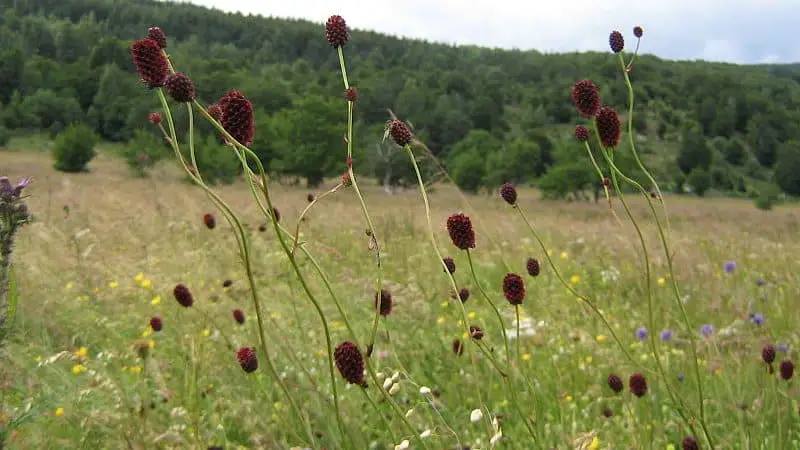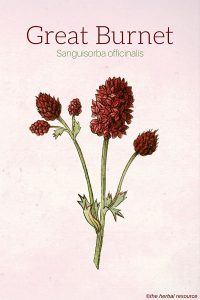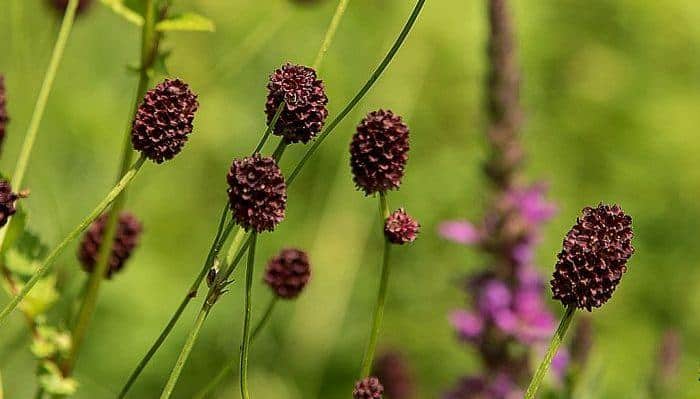Botanical Name: Sanguisorba officinalis.
Other Common Names: Greater burnet, garden burnet, official burnet, burnet bloodwort, common burnet, salad burnet, sanguisorba, Grosser Wiesenknopf (German), pimprenelle officinale (French), pimpinela mayor (Spanish), blóðkollur (Icelandic), blodtopp (Swedish).
Habitat: Great burnet is a widespread plant in Europe, North Africa and temperate areas of Asia.
It is cultivated in northern and northeastern parts of China for commercial use. It has been naturalized in some places in North America.
Plant Description: Great burnet is a perennial of the rose family (Rosaceae) that can reach between 30 and 90 cm in height.
The plant has a coarse primary root and dark brown, short rhizomes. The rhizomes give rise to branched flower stalks. The leaves are blue-green and heart-shaped.
The plant blooms from June to July and the flowers are small and dark red. The fruit is a small nut and contains one seed. Great burnet grows in damp areas, meadows, pastures, and ditches and prefers alkaline soil.
Plant Parts Used: The rhizomes, roots and the fresh or dried aerial parts of the herbs have been used in herbal medicine.
The aerial parts are collected when the plant is in bloom.
The root and rhizomes are usually collected in the autumn and cut, washed and dried for later use. It is best to use roots from plants that are few years old.
The taste of the root is bitter and sour.
Therapeutic Uses, Benefits and Claims of Great Burnet
The main substances found in great burnet are flavonoids, saponins, ursolic acid, arabinose, essential oil, vitamin C, and tannins.
The scientific name Sanguisorba refers to the herbs medicinal properties where “anguis” means blood and “sorb” means “to suck up”.
For centuries the plant has mostly been used as a hemostatic agent both in Western and Chinese herbal medicine.
The rhizomes of great burnet contain a high amount of tannins (up to 17% ) which are responsible for the astringent, antiseptic and anti-inflammatory properties of the herb.
In both Chinese and Western herbal medicine a decoction of the root has been used internally for heavy menstrual bleeding, blood in stool and urine, bleeding hemorrhoids and uterine bleeding.
Because of the astringent and anti-inflammatory action of the plant it has been utilized in the treatment of a variety of digestive disorders, such as diarrhea, dysentery, enteritis, ulcerative colitis, irritable bowel syndrome and irritable colon.
Great burnet has demonstrated in vitro an inhibitory effect on many pathogenic bacteria such as Staphylococcus aureus, Streptococcus pneumoniae and Pseudomonas aeruginosa.
A mouthwash can be made from the herb and used as an herbal treatment for gum inflammation and swollen tonsils.
Great burnet has been used externally as a folk remedy for nose bleed, wounds, burns, eczema, rash, boils and hemorrhoids.
The young leaves and shoots have a nice taste and can be eaten raw or used in salad. For this use, the plant should be harvested before it blooms.
Dosage and Administration
To treat burns, the powdered root can be blended with sesame oil and then applied to the affected areas.
In Chinese herbal medicine, the normal daily dose for internal uses is 10-15 g. For external usage, the recommendation is “as much as needed”.
For further information on an appropriate dose for a specific ailment, a trained herbalist or a healthcare provider should be consulted.
Side Effects and Possible Interactions of Great Burnet
No side effects or contraindications have been indicated when great burnet has been used as a medicinal herb but due to the lack of data on the pharmacological effects and toxicity of the plant, it should not be used by women who are breastfeeding or during pregnancy.
Because of the high content of tannins the herb should not be used continuously over a long time.
Supporting References
van Wyk, Ben-Erik & Michael Wink: Medicinal Plants of the World. Portland, Oregon. Timber Press 2004.
Wu, Jing-Nuan: An Illustrated Chinese Materia Medica. New York. Oxford University Press 2005.
Bartram, Thomas: Bartram’s Encyclopedia of Herbal Medicine. London. Robinson 1998.
Bown, Deni: The Royal Horticultural Society New Encyclopedia of Herbs & Their Uses. London. Dorling Kindersley 2002.
Barnes, Joanne; Linda A. Anderson & J. David Phillipson: Herbal Medicines: A Guide for Healthcare Professionals. 2nd Ed. London. Pharmaceutical Press 2002.
Thordur Sturluson
Latest posts by Thordur Sturluson (see all)
- What is the Difference Between Hemp and Marijuana? - June 3, 2019



Leave a Reply